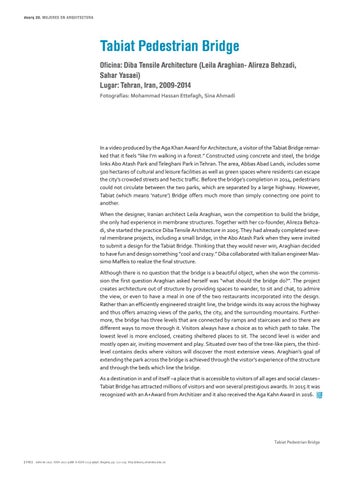dearq 20. MUJERES EN ARQUITECTURA
Tabiat Pedestrian Bridge Oficina: Diba Tensile Architecture (Leila Araghian- Alireza Behzadi, Sahar Yasaei) Lugar: Tehran, Iran, 2009-2014 Fotografías: Mohammad Hassan Ettefagh, Sina Ahmadi
In a video produced by the Aga Khan Award for Architecture, a visitor of the Tabiat Bridge remarked that it feels “like I’m walking in a forest.” Constructed using concrete and steel, the bridge links Abo Atash Park and Teleghani Park in Tehran. The area, Abbas Abad Lands, includes some 500 hectares of cultural and leisure facilities as well as green spaces where residents can escape the city’s crowded streets and hectic traffic. Before the bridge’s completion in 2014, pedestrians could not circulate between the two parks, which are separated by a large highway. However, Tabiat (which means ‘nature’) Bridge offers much more than simply connecting one point to another. When the designer, Iranian architect Leila Araghian, won the competition to build the bridge, she only had experience in membrane structures. Together with her co-founder, Alireza Behzadi, she started the practice Diba Tensile Architecture in 2005. They had already completed several membrane projects, including a small bridge, in the Abo Atash Park when they were invited to submit a design for the Tabiat Bridge. Thinking that they would never win, Araghian decided to have fun and design something “cool and crazy.” Diba collaborated with Italian engineer Massimo Maffeis to realize the final structure. Although there is no question that the bridge is a beautiful object, when she won the commission the first question Araghian asked herself was “what should the bridge do?”. The project creates architecture out of structure by providing spaces to wander, to sit and chat, to admire the view, or even to have a meal in one of the two restaurants incorporated into the design. Rather than an efficiently engineered straight line, the bridge winds its way across the highway and thus offers amazing views of the parks, the city, and the surrounding mountains. Furthermore, the bridge has three levels that are connected by ramps and staircases and so there are different ways to move through it. Visitors always have a choice as to which path to take. The lowest level is more enclosed, creating sheltered places to sit. The second level is wider and mostly open air, inviting movement and play. Situated over two of the tree-like piers, the thirdlevel contains decks where visitors will discover the most extensive views. Araghian’s goal of extending the park across the bridge is achieved through the visitor’s experience of the structure and through the beds which line the bridge. As a destination in and of itself –a place that is accessible to visitors of all ages and social classes– Tabiat Bridge has attracted millions of visitors and won several prestigious awards. In 2015 it was recognized with an A+Award from Architizer and it also received the Aga Kahn Award in 2016.
Tabiat Pedestrian Bridge
[ 112 ] Julio de 2017. ISSN 2011-3188. E-ISSN 2215-969X. Bogotá, pp. 112-119. http://dearq.uniandes.edu.co
